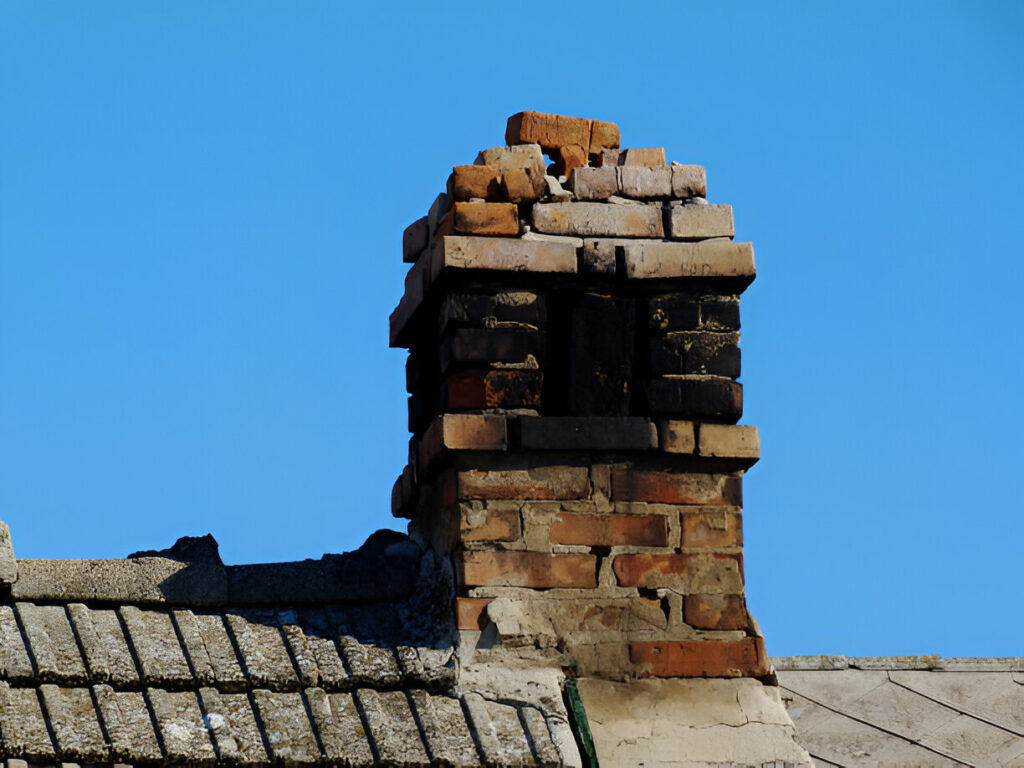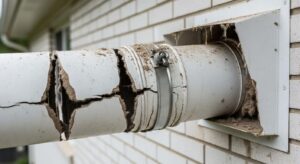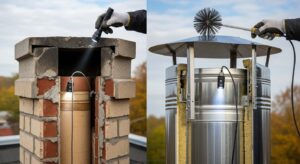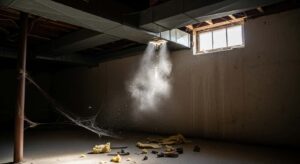Chimneys are extremely durable, lasting even a hundred years or more. So why do people start searching for a solution to the issue of “Why is there a crack in my chimney?” It is a good idea to know why you need a chimney repair in NJ, because a chimney should be functioning well, both for safety and to avoid the threat of a possible collapse.
Whether your chimney is in dire need of a repair or you want a thorough chimney maintenance, Clean Air is the right service provider you need. With a diverse service portfolio including maintenance, replacement, and chimney repair in NJ, you can trust us to get the job done efficiently and promptly.
Reasons Behind a Cracked Chimney
To find where a leaky chimney is coming from, you would have to know the most likely reasons your chimney would leak. If your chimney is in good shape, then your leak is probably somewhere else in your roof structure.
1. Rain Falling In From the Ceiling
Missing or Damaged Chimney Cap
Problem
The initial defense against rain entering your house is chimney caps. Without a chimney cap, you are letting not just rain, but also birds and animals into your chimney system. This leads to leaks and the possibility of a blockage from an animal nest, which lets rain inside where it does not belong and then freezes, causing harm to your chimney liner’s mortar joints. Chimney caps can be blown off or destroyed in storms, or can be installed incorrectly.
Solution
Chimney caps are readily available, and your requirements will be based on what kind of chimney and liner you have. If you have a typical clay lining or a stainless steel lining, your cap will be held in place by screws that directly fit into a piece of your liner kit, or simply bend over onto your chimney flue with pressure when screws are screwed onto the outside of the flue. Some chimneys have multiple flues, which will enable you to fit a larger cover over the top of your entire chimney.
The high-quality chimney covers range in price from approximately $160 for a single flue chimney cover and approximately $450 for a multi-flue chimney cover. You will want to select a quality chimney cap, like a stainless steel or copper one, and have it properly installed as instructed by the manufacturer. Most quality chimney caps carry a limited lifetime warranty, so if you ever experience any problem, you will be covered.
Missing or Damaged Chimney Crown
Problem
Your crown is the cement at the top of your chimney. Your chimney should have an airspace between any tile flue liners and the stone or bricks your chimney is made of. Rain and animals might be able to travel down this airspace without a crown. Cracks will eventually appear in the crown naturally from settling or from shrinking. Any little crack will let water in.
Solution
The solution will rely on how severe the damage to the chimney crown has been. If the damage has been severe enough, the ideal solution is to take down and replace the chimney crown. Most crowns have minor cracks and can be repaired by putting a special elastomeric coating over the cracks to seal them and remain flexible and waterproof. Even if you only have minor leakage, the minor cracks must be repaired as soon as possible to keep water from freezing in the cracks and expanding them.
2. Rain Coming In From the Side
Broken Bricks and Mortar
Problem
Bricks and mortar are permeable and will naturally take in water. Water can be drawn in over time and, when it freezes, will expand. This will cause cracking of bricks or mortar, or the opening up of gaps through which water can enter.
Solution
The moment that cracks or gaps exist, water will and does manage to seep into your house and chimney. Cracked bricks can be fixed by having them removed and replaced one at a time by a mason. If you have several cracked bricks, you might be told to rebuild part or all of your chimney. Your mortar is likely to be the first to go bad because it is weaker than the bricks. For most cracks or mortar separations, a simple tuck-pointing repair will suffice.
Prevention
Waterproofing your chimney is of the utmost importance, and even more so, ensuring that the waterproofing process is completed properly. To begin with, you will need to consider whether your chimney has ever been waterproofed previously. Water-based products are a great option for initial applications. Otherwise, you will need to utilize a solvent product. Once you have chosen your product, ensure that you carefully read all of the manufacturer’s instructions and apply it at the right moment. The last thing you would want to do is seal moisture permanently within your bricks and mortar.
3. Rain Coming In Where Your Roof Meets Your Chimney
Poorly Sealed or Damaged Chimney Flashing
Problem
Your chimney either projects directly out through the roof, or at least butts directly up against it. This is a great spot for water to enter. Roofers and masons keep water out at these vulnerable spots with flashing. Flashing is a metal piece that is used to keep water out of the intersection of a roof with another surface. Flashing on your chimney should be tight against your chimney and your roof. Additionally, it should be sealed, becoming airtight and watertight, to keep water from getting onto your chimney and redirect it to your gutters. No matter how good a mason or roofer is, eventually that flashing is going to pull away from the surface, either from the natural settling of your house or storm damage.
Solution
Once flashing begins to separate, your only recourse is to have it replaced or repaired and resealed. There are a number of products available that will seal chimney flashing. We suggest that you avoid the tar-like sealant and use something that will stretch a little when your house settles and shifts
4. Not Rain but Condensation
Condensation Due to Inadequate Lining of Chimneys
Problem
Your chimney area is damp or wet, and you have no idea why. Everything seems to be working as it should, but the water keeps collecting, peeling paint or wallpaper, and making mold and mildew before you spend a lot of money and time figuring out why, consider this: Condensation. When air travels up the chimney, it contains moisture. Without a tremendous amount of heat pushing the moisture up the chimney and into the air, the water will build up inside your chimney, condensing and working its way into your house. This happens when you or the previous owner have upgraded the furnace or appliance to a more energy-efficient model without making the necessary changes to the chimney itself. New appliances are a lot more energy-efficient, pushing less heat up the chimney and more into your house. Without the same heat going up the chimney as the old appliance, the water vapor might never make it out of the chimney and into your house.
Solution
The right-sized chimney liner will cause the cooler fumes produced by the more efficient unit to push the water vapor out where it needs to go – into the air. If you have an unlined or large-capacity chimney or a new unit and believe you have a condensation issue, fix it by having a professional chimney repair in NJ.
5. Rain Coming in from another Location
Not a Chimney Leak
Problem
Water travels where it can travel, and people have a hard time comprehending that the source can be far from the problem. We anticipate that the problem will be where we observe the visible water damage.
Solution
Take a few minutes to look over the most typical sources of leaks listed in this article. Most issues are simple to observe from ground level, but if you can get to your roof, the better. Trust your instincts and make the call. Experts for chimney repair in NJ are the best option to fix chimney leaks. Roofers are the obvious option if you think your roof is leaking. Hopefully, by reading this article, you already know where the source of your leak is.
Chimney Construction Problems That Might Result in Cracked Chimneys
The construction of a chimney is most important. If any step is omitted or done in the wrong manner, the outcome can be a defective chimney. Some of the problems encountered during construction are given below:
- The bricks or blocks that are used to construct the chimney may be faulty, though this is highly improbable. Faulty bricks with poor-quality mortar can lead to cracking, though.
- There are specific building guidelines for a concrete footer on a chimney. If you get this portion of the building process wrong, the outcome may be a crack in your new chimney. Footers in general must be a foot thick and 12 inches on each side of the footprint of the chimney. There must be 5/8-inch steel bars set a few inches down from the bottom of the footer, and many other bars. The bars must not sag or drop when you are pouring cement.
Negative Impacts of Wind on a Chimney
Cracking in a chimney is often not unrelated to wind. Mortar is not as strong as it will become after weeks and sometimes months. Stresses caused by strong winds may cause a crack if a new chimney is subjected to strong winds. Steel rods inserted inside the chimney can eliminate the possibility of wind cracking a new chimney.
Also Read: Do Gas Chimneys Need To Be Cleaned?
Is a Faulty Chimney Hazardous?
If a chimney is compromised by an error in the construction process or even just by general wear and tear, it can be extremely hazardous. Chimneys can actually collapse with little or no notice, which can result in damage and even loss of life.
If you need any information regarding your chimney’s health or if you need to have a crack fixed in your new chimney, then call Alpha Clean Air for chimney repair in NJ. We have all our technicians trained, licensed, and ready to offer you a fair inspection of your chimney and any repair that you might need.





